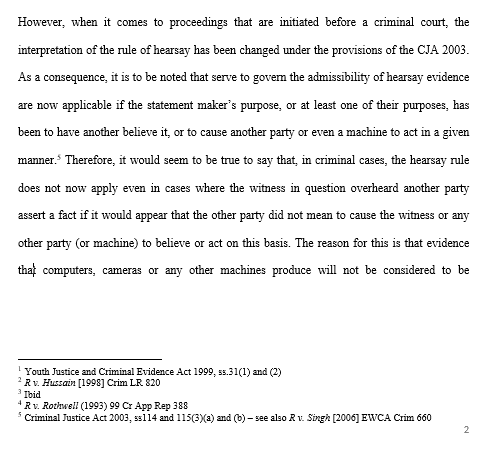Footnotes within academic writing take two forms. The first is when referencing sources, the second comes in the form of additional, supplementary material that isn’t necessarily required in the main body of your essay. The two style must never overlap, and you may be penalised for putting supplementary material into an essay that has a footnoted reference style. Learning how to write footnotes will benefit you throughout your academic career and beyond, so take some time out to learn how it is done correctly.
Footnotes in Referencing
The most common reference styles using footnotes within UK academia are OSCOLA, Chicago, Oxford and occasionally Turabian. Instead of the more commonly seen Harvard or APA referencing system, the in-text citation is not placed in brackets after the corresponding information. Instead, you place a superscript number after the corresponding information. This number is then duplicated in your footer at the bottom of the page with the information you would normally enter into a reference list. Remember that each referencing style will have different ways of correctly entering this information so check with your university’s referencing guide to be sure you do this correctly.
To enter a footnote into your work, (assuming you are using Word for word processing your documents) place the cursor in your work where a reference is required, then select the references tab across the top of the page and select insert footnote.

The footnote should look something like this:

You can see that the superscript number is placed in the text and the corresponding information is given next to that number in the footnote. You can also see from this example that ‘Ibid’ is written next to number 3. This is used where the reference for number 3 is the same as number 2; you may need to add an updated page number next to this. Be mindful that some universities and styles such as Chicago do not like the use of Ibid and prefer a shortened version of the reference to be used instead. Other styles such as OSCOLA (used in the example) will require Ibid to be used. Again, it is important to check which your university prefers.
Dos and Don’ts
Remember that all referencing is a case of avoiding plagiarism. We must credit other authors and researchers’ ideas always. Quotes and theories given to us by theorists are also required to be referenced. Do not worry about how many superscript numbers you are entering into your work; it is better to enter a reference and credit an idea to an author than to be later accused of plagiarism.
It is important that your numbers remain chronological and are not repeated, even for repeated references or ideas. The numbers must flow from 1 onwards.
Most footnote reference styles still require a bibliography at the end of the paper. Check your assignment brief to see whether this is required. Even though you may feel you are repeating information already in your footnotes, often your referencing style in the bibliography will be presented differently to in a footnote. For example, in footnotes, authors names are not inverted, whereas in a bibliography, they are.
Remember to place your superscript number straight after the idea, theory, or data you are sourcing. This can be mid-sentence if required. If the entire paragraph refers to an idea, theory, or data then the number can be placed at the end of the paragraph.
Don’t forget to enter your footnotes into your paper in a smaller font than your main essay. If your main essay is written in size 12 font, write your footnotes in size 10.
Supplementary Information Footnotes
If your paper uses a different referencing system to the ones such as Harvard, APA, or MLA, you may want to use footnotes to give additional information to the reader which is not required in the main body of text. Footnotes can be useful in this way so as not to contribute to the word count and can help to define complicated words or give some background information which you feel is not strictly necessary but may be helpful. These little snippets of additional information can often disrupt the flow of reading if added into the main body.
The footnote will be placed in the same way as demonstrated above, with a superscript number, but instead of placing sourcing information into the footer, you would simply write the supplementary material into the footnote space.
It is important to check your assignment brief to check your course and tutor allow footnotes to be taken into account. Some courses do not allow footnotes to be used and will not take the information contained within them into account. Others will count them towards a word limit. With this in mind, it is important not to put essential information into a footnote or to treat it as an extension of your word count.
It is important to remember that if you want to provide necessary information, use of an appendix may be a more appropriate technique for providing supplementary material. Use of long-winded definitions, tables, graphs, frameworks and supporting data are more appropriate in an appendix and simply writing ‘as seen in appendix 1’ into your work would be the correct way to reference this.